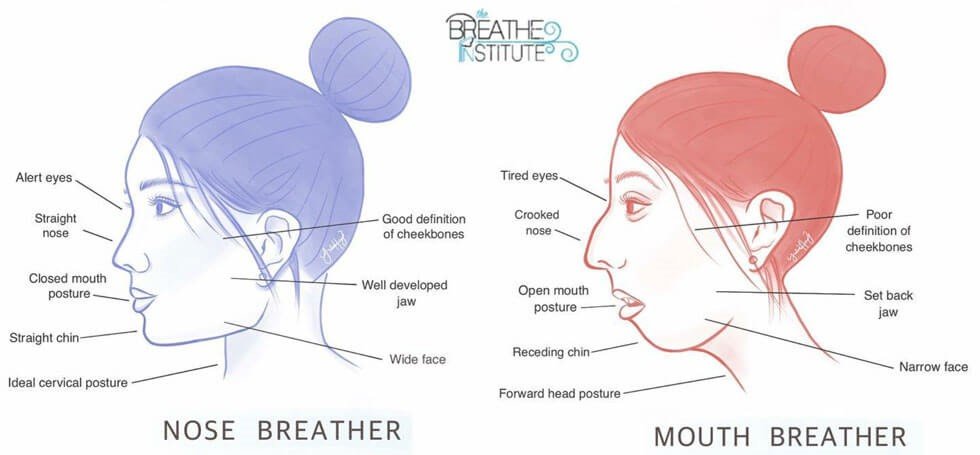Are You Breathing? No Really ... Are You?

Are you breathing?
Don’t be ridiculous, of course I am breathing!
But HOW are you breathing is the million-dollar question. Breathing is our innate universal life force. Our first breath ignites us into this world, and our last breath extinguishes us from it. Yet despite knowing this, many of us have not stopped to question if we are performing this life supporting function correctly.
The breath is our VIP (very important power) access to our body and mind. The way we breathe is the way we live. The way we breathe influences every aspect of our lives – ability to concentrate, quality of sleep, facial structure, athletic performance, clarity of mind, our physical and mental health and so on. SO, let’s dive in!
NOSE VS MOUTH BREATHING
Where do you breathe from? Your mouth (chest) or your nose (diaphragm)? About 30-50% of people are mouth breathers. Take a moment now to check for yourself!
Place one hand on your belly and other on your chest. Tune into your breathing for a few rounds of breath, notice which hand moves the most. If it’s your upper hand, you are likely to be breathing from your upper chest. You can also check to see if your shoulders rise and fall when you breathe, another sign of chest breathing. When diaphragmatic breathing, you should feel an outwards expansion from your side body, just below the ribs.
| NOSE | MOUTH |
| Responsible for 30 functions in body | Does not play essential function in breathing |
| Connected to our diaphragm | Connected to our chest |
| Slow breathing, activates parasympathetic nervous system – stress relieving | Fast breathing, activates sympathetic nervous system – stress inducing |
| Increased oxygen uptake in lungs and delivery to body due to higher levels of CO2 | Decreased O2 uptake in lungs and delivery to body due to low levels of CO2 |
| Tongue on roof of mouth opens airway, widens the jaw, and straightens the teeth +nose | Tongue blocking the airway, dropping the jaw and resulting in crooked teeth and nose |
| Release of nitric oxide (NO) – the body’s natural defence mechanism, and broncho + vasodilator | No release of nitric oxide, an essential gas to aid respiration, circulation, and immunity |
| Saliva contained and hydration improved | 42% more water loss from body – dehydrating |
| Efficient and economical breathing | Stressed and inefficient breathing |

HOW TO BREATHE? Do you suffer from breathlessness, asthma, snoring or sleep apnoea, anxiety, susceptibility to panic attacks, difficulty focusing, general fatigue and never feeling truly rested after sleep, or do you find nasal breathing uncomfortable? If so, chances are you are breathing through your mouth and thus your breathing pattern needs some attention!
According to Patrick McKeown who has been studying the breath for over 20 years, there are three pillars to breathing – Long / Slow / Deep (LSD) breathing through the nose. They combine to become more than the sum of their parts, with each pillar supporting and influencing the other.
Long Lengthening your breath allows for more O2 uptake in the lungs due to 50% more resistance in the nasal air stream rather than the mouth. The longer the nasal breath; the more CO2 available for O2 to be released from the red blood cells and delivered to the body and brain. Mouth breathing expels too much CO2, leaving inadequate levels to aid the release of O2 from the red blood cells, therefore resulting in low O2 availability to the body.
Slow The ideal breath rate is 6 breaths per minute. This slow pace allows for a higher concentration of nitric oxide (NO) to be released from the nasal cavity, which dilates the airways and blood vessels for efficient flow of O2 and nutrients within the body and supporting healthy blood pressure levels. More NO also increases the body’s immunity as it contains antifungal, antiviral and antibacterial properties. As we may have experienced, the pace of our breath directly correlates to the pace of our mind – so to slow down the mind we must firstly slow down the breath. A calmer mind brings greater clarity and concentration.
THE BENEFITS of NASAL BREATHING IN SUMMARY:
- Increased oxygen uptake in lungs and delivery to body
- Increased concentration and focus with more oxygen to brain
- Slows the breath and therefore calms the mind
- Improves sleep and corrects sleep disorders
- Engages the diaphragm muscle and increases lung capacity
- Reducing tension in the upper chest
- Encourages good posture through supporting the spine
- Activates parasympathetic nervous system and reduces stress levels
- Improves athletic performance with more efficient oxygenation of body and brain
- Improves facial structure, jaw development and reduces malocclusion (crooked teeth)
- Massages internal organs; improving digestion, bowel function and circulation’
BREATHING EXERCISES Here are a few breathing exercises to practice training yourself to nasal breathe. Please don’t expect drastic change overnight, as with learning any new skill or changing a habit it will take time. Be patient and consistent with your practice!
Relieves Nasal Congestion
- Inhale and exhale normally
- Pinch your nose after the exhalation
- Shake your head up and down until you feel mild breath hunger
- Return breath to normal and repeat 6 times
Extending Breath Retention
- Inhale and exhale normally
- Pinch your nose after exhalation
- Walk around holding your breath until you feel mild breath hunger
- Return to breath to normal and repeat
Mouth Taping
- Be sure you can breathe through your nose (ie no structural damage, blockages or congestion – if so tend to those concerns first)
- Tape your mouth closed during the night
- Use normal medical white tape, or specialised mouth tape
- Great way to reduce snoring, overcome sleep apnoea, and encourage restful sleep
I hope this has been helpful, interesting or at the very least I hope your mouth is now closed! Reassuringly, the good news is it is never too late to change your breathing patterns! Your longevity, quality of life and your good looks depends on it. Be sure to click on the links below to delve deeper into the fascinating force and function that is your nose… and your breath! So, with that my friends may you continue to breathe long, slow, deeply, and of course through your nose.
A big thank you to Hannah Hokarari from Snaffle Your Challenge for this guest blog. If you enjoyed this and would like to read more articles head to www.snaffle.com.au or follow her on Instagram.

Contact us Today
Contact: www.madisonhealthstyle.com.au to book an appointment today.


